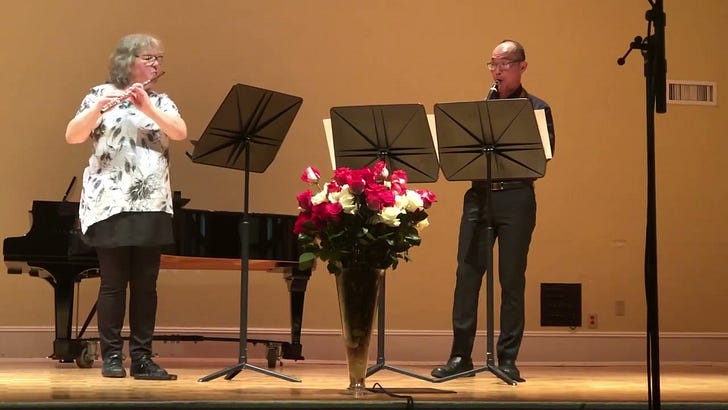From Apparition to Inspiration
In the last couple of posts, I have been writing about inspiration. In “Inspiration is a Lucky Penny” I write about how finding inspiration requires discipline and practice. It doesn’t just happen. You have to keep an eye out for it, just like paying attention to changes in light can lead you to a lucky penny.
In “An Attack of the Zielschmerz” I gave an example of how I found inspiration in a new word I learned in an email newsletter I read regularly.
Today’s post is about how I grew inspiration from a spark (or, rather, a smoldering ember) into a fully engaged fire.
A piece I wrote last fall started with a feeling. A vague feeling.
I knew I was going to write a piece for flute and clarinet, and I knew I wanted to explore microtonality and multiphonics. But that was all I had.
Part of my compositional process involves connecting my music to extra-musical sources. It helps keep me on track with form, motives and colors I want to use in my piece and excluding the ones that don’t help to convey the idea of the extra-musical source.
That is where I was stuck. I didn’t have an extra-musical source. I only had a vague feeling. I kept searching for what this vague feeling was pointing at, for about a week, with no success.
Then the solution came to me: use my favorite resource, the THESAURUS.
I looked up “vague” in the thesaurus, and I went down the rabbit holes thesauri lead to, following all the tunnels between words, searching for the just the right word that would solidify the inspiration.
I finally found it: Eidòlon.
Eidòlon is an ancient Greek word that refers to an apparition or an ideal – a ghost, a fantasized hero, or even an idol.
This was the vague thing.
After that, I took another step in my artistic process and looked up other artwork associated with “Eidòlon.”
Low and behold, I found Walt Whitman’s poem, Eidòlons!
The poem is amazing. You can read it here.
I was drawn immediately to two stanzas. The first is this:
Lo, I or you,
Or woman, man, state, known or unknown,
We seeming solid wealth, strength, beauty build,
But really build eidòlons.Join my Monthly Digest
If you enjoyed reading this post, please subscribe!
Once a month, I send out a newsletter by email. Sign up so you don’t miss the latest blog posts, upcoming performances, new score releases, current projects, and other news!
Subscribe
We won’t send you spam. Unsubscribe at any time.
I was reminded of the biblical book of Ecclesiastes.
All this STUFF we amass? It means nothing. We think money will get us somewhere. Or physical strength (or political power?) Or beauty? We build stuff…like houses. We collect treasures. But it will all be gone. It doesn’t last. We can’t take it with us when we die. It’s all just a phantom in the end.
Eidòlons!
King Solomon called it “a chasing after the wind.”
I was reminded, too, of what Jesus said, “Do not build up for yourselves treasures on earth, where moth and rust destroy and where thieves break in and steal. But build up for yourselves treasures in heaven, where moth and rust do not destroy and where thieves do not break in and steal. For where your treasure is, there your heart will be also.” (Matthew 5:19-21.)
After reading Whitman’s poem, I knew why I was feeling so “vague.” This was the first piece I wrote after moving to North Carolina and starting my master’s degree in music.
My old life was gone. I moved away from friends and family, and we left our house.
Our house.
We loved it.
It needed work – more than we could afford to fix, really, but the land was even better – a very quiet 2-1/2 acre oasis in the woods. It was hard to leave that. I still miss it.
I have kept in touch with my friends and family, of course, but we will never get that property back.
But you know what? It was an eidòlon. Something that doesn’t last.
The poem spoke to the intense feelings I was having about leaving a home – something that represents (to a degree, anyway) security and financial success – to pursue artistic development, which on the surface looks like almost the complete opposite.
No wonder I was feeling so “vague.” I was perceiving the eidòlons.
This next stanza also stood out to me:
Ever the dim beginning.
Ever the growth, the rounding of the circle,
Ever the summit and the merge at last, (to surely start again.)
Eidòlons! Eidòlons!After reading it, I decided to make the form of my piece into an “imperfect mirror” which means that the end of the piece is a reflection of the beginning. Which it mostly is, but not exactly. I won’t bog you down with the details, but I will say it is “imperfect” in the way ripples in water may not reflect every bit of an image accurately.
My piece explores the blurred reality of pitch and rhythm through a nebulous sense of meter and tunings that seem “not quite right” based on multiphonics and microtones between the pitches Western ears are accustomed to.
Eidòlons! Eidòlons!
Here is a video of the premiere at the International Festival of Music by Women, on March 8, 2024. Dr. Soo Goh is playing clarinet, and Carol Shansky is playing flute. Many thanks to them for their willingness to bring this piece to life, and for their encouragement of my work. They did such a great job!
I’d love to hear your thoughts – on the poem, on the idea of eidòlons, on the piece! Leave a comment!


